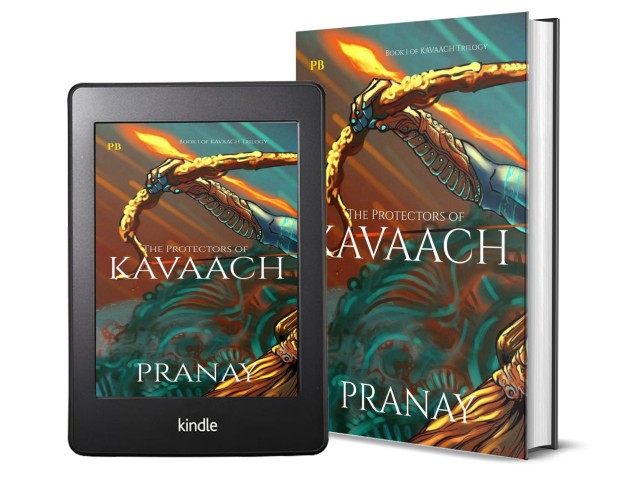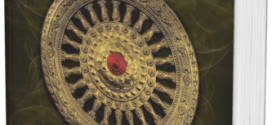The perks of being a book lover includes exposure to many virtual worlds. Some of them are so live and beautiful that you may want to stay there, despite the challenges.
This Is Here In For You
Listen To The Podcast:
If you love to listen to the book review over reading, or if you want to go through it while doing other activity, here is our Podcast of this review article. Do listen, and share your thoughts with us.
Spotify:
YouTube:
And yes, we get chances to meet some remarkable and imaginative wordsmiths on our journey.
Recently we came across an interesting book THE PROTECTORS OF KAVAACH: Book 1 of KAVAACH Trilogy by Pranay Bhalerao.
| Book Title | : | The protectors of Kavaach Book 1 of Kavaach Trilogy Kavaach Trilogy - 1 |
| Author | : | Pranay Bhalerao |
| Published by | : | Notion Press ( 16 August 2022) |
| # of Pages | : | 364 (Paperback) 449; 993 KB (Kindle EBook) |
| Purchase Link(s) | : |
|
While this is his first book, he is so confident that in the title itself he mentioned that it is the first of a trilogy! And, after reading the book, I can vouch that it is not over-confidence. The story is written nicely and there are so many elements which are waiting for the future actions as well as backstories. We are eager to explore those parts upon release.
Book Cover:
While the cover page cannot be the only judging factor for the book it is associated with, it is definitely amongst the prominent ones. Being a gateway to the virtual world explored withing it makes the first impression of the book. And thus, it can influence remarkable number of purchase and/or read decisions.
As you can see the cover page of “The Protectors Of Kavaach” is really attractive. The cheerful colors used for the cover page are enough to catch a casual browser’s attention.

The protectors of Kavaach by Pranay Bhalerao | Book Cover
Kavach means a body armor and the one referred here is believed to be of golden color and having sparkling shine. It is the same Kavach that Karna (from Mahabharat) was blessed with. The illustration of the same is believable.
Actually we see a part of a faceless warrior in action mode and we see glimpses of the Kavach in this illustration. We see an arrow omitting fire is launched on the bow. The extended hand of the warrior has the arm-protector part of the Kavach visible.
The fonts used for the book title and other information goes in sync with the theme.
I like the cover page concept and illustration.
The Story:
Let us take a bird’s eye view of the story.
The story follows various tracks and in each the incidents are happened at different places. Here I am listing some of the prominent timelines and locations:
- Prologue: 555 BCE, Om Parvat.
- 570 BCE, Kurukshetra battlefield and Mahant Ashram, Kurukshetra.
- 600 BCE, Mahant Ashram, Kurukshetra.
- Present- day, Shivgarh in Maharashtra, New Delhi, Sinauli in Uttar Pradesh
The Mahabharat/Mahabharata war is just ended and a sage is visiting the battlefield. He was an accomplished sage and was under protection of Lord Indra himself. What he saw in front of his eyes was unbelievable. A “siddha rakshasha” who cannot be overpowered was also finding something important there!
The sage has to run away and warn his disciples and fellows to hide the precious thing to a place unknown.
And the journey begins.
In the ashram of a well respected and spiritually powerful sage, a group of students studied. The current tutor, his son, was under oath to teach only to future kings.
It was the most respected ashram and all the kings of Sapta Sindhu region wanted their princes to be educated there.
The brightest amongst them was Aryana.
One day when the guru has given a tough task to his students, an unknown boy came to visit.
He seek a place in the ashram as a student. But, the guru was reluctant based on his oath.
Surprisingly, the boy completed the task which none of the students were able to do!
He performed some other stuff and eventually created a soft-spot in the sage’s heart and upon his insistence the guru has accepted him as a disciple. With a hesitation, of course.
He (the teacher) sensed something wrong, though, he cannot figure it out.
And things took its course.
In a small hilly town of Maharashtra, a young fellow name Rudra lived with his grandfather. Ravi is his best friend. Rudra’s parents are no more, his grandfather, a well-versed, well-respected person means world to him.
There is a structure named “Trishula” in the village. Rudra’s family is taking care of it since generations.
Trishula is a mysterious place where the incidents of Mahabharat were engraved was considered to be there since the time of actual Mahabharat.
Rudra has a birthmark and he was destined to play a major role in coming times. He was unaware of it, but his grandfather knew about it and was careful about well-being of Rudra. He keeps him blessed with different auspicious ornaments and sacred thread.
A company has found coal in the mines around that place and has starte working there. Rudra and other are helping them and in exchange the company has taken responsibility of doing the needful for Trishula.
A Lord Shiva devotee, somewhere in Delhi is looking for something and trying all he can to find and get it.
What it is? Who he is? And, what are his plans?
Well, you need to read the book to get your answers (and more questions). Over the journey you come to meet or know about various characters like: Saharshee Mahant, Kaal Vashishth (Kaal), Krishnajeet Mahant, Rudra, Ravi, Tanya, Shaurya, Teena, Shaksheet, Meera bai, Ganga Mahant, Saras Mahant, Swami Shankarakhanda, Bhavani, King Aryana, Krishna Shankar, Dambhodbhava, Vikrant Nair, Ira, Adinath, Prakhar Khanna, Kaleem Zaidi, Shashwat Mahant, Saras, Pawan Verma, Nandini, Vikramacharya, and others.
Views and Reviews:
The fictional story explored in the book is really interesting. The way the author has connected various dots to various characters and incidents found in the ancient Bharatiya (that is Indian) literature are worth praising.
The strong characters are a positive aspects of the book.
We had seen many stories (mostly written by debutante authors, but seasons authors also sometimes fell for it) build the character of the protagonist(s) very effectively. But, don’t give that much weightage to the antatonists. According to me when you make the antagonist really strong, the hero appears even stronger.
This book is a pleasant exception. Here the author has given enough space to all the important characters. Even the sidekicks got their due.
The way, the author introduces us to various characters is interesting, for example:
Mahant, one of the most respected sages of the Sapt Sindhu, the land of seven rivers, looked at the massive Himalayan mountain covered with snow.
See, how the legendary persona of the character is conveyed to the reader and at the same time, his current location is revealed effectively. And when talking about the abilities of the characters, despite the characters belong to the ancient times, the author uses logical lines like:
They had the skill to adjust their body temperature as per the climate.
Rather than talking about mystical powers etc. the author has talked about skills and abilities, to make the characters more real. And, that works in favor of the book, as per my opinion.
Here are a few character defining lines from the book:
A well- educated young man refused multiple job opportunities from leading multinational organisations.
– – – – – – – – – – – – – – – – – – – – –
Rudra was famous in his circle for jumping in the waterfall. He would go to the right opening of The Trishula and would swim till the left.
– – – – – – – – – – – – – – – – – – – – –
His childhood friend, Ravi, believed that he could communicate with the river.
– – – – – – – – – – – – – – – – – – – – –
This village and the Trishula is my life. I will do whatever it takes to make it better.’
And, the same is true for the antagonist and his team as well.
Shaurya was a notorious head of the underground Syndicate. A syndicate involved in the research of the Mahabharata. He knew the ancient secret, inherited it from his bloodline. He had a rich knowledge of all the Vedas and Hindu epics. He was one of the rare Siddha Tantric of the world. He aced the Tantra- Vidya and Shastra- Vidya.
– – – – – – – – – – – – – – – – – – – – –
Bhavani was a man with skills and an evil mind.
And the skilled antagonist is analytical too:
‘Look out for the active magnetic fields and weak nuclear radiations.’ said Shaurya handing them two devices.
The author is good at explaining surroundings and buiding scens. The way he talks about the Mahabharata war, the brutality happened there and a fictional incident after that,… all those are convincing descriptions. Here are a couple of such lines:
On a misty night, a man with a flambeau stopped on the grounds of Kurukshetra, the battlefield of the greatest war in Sapt Sindhu, Mahabharata.
– – – – – – – – – – – – – – – – – – – – –
The red soil spread over the horizon was believed to be the blood of the great warriors who fought in the battle.
Here are a few more interesting lines I like to quote:
A young man with yellow Angavastram and white dhoti paced through the dense forests towards the Ashram.
– – – – – – – – – – – – – – – – – – – – –
The lights were not working, and the dark lane welcomed him with the flickering lights.
– – – – – – – – – – – – – – – – – – – – –
The security troops had already taken their rightful places. Even in the prime of devotion, faith and tenderness, the security was never compromised.
– – – – – – – – – – – – – – – – – – – – –
The hospital security had done a great job keeping the media personnel out of the hospital premises.
As you can see, be it the character description, the environment or the mood in a scene, I found the author is good at writing them.
The author is good at elaborating emotions through words. Here is an example:
His eyes were red with anger, and the sky was crying with him.
It had turned red with the fury of thunderstorms.
– – – – – – – – – – – – – – – – – – – – –
Kaal loosened his grip and let gravity do its magic.
The way the education system was working on those ancient days and how personally the gurus were taking the responsibility of their respective desciples is elaborated in the book in a very long segment involving the attack at the ashram and its aftermath.
Such gurus liked to be sure that they choose the right desciples and giving them the knowledge they deserve, help them sharpen their skills and support them in being powerful to protect the society. Only such gurus can say the following:
‘I taught you everything except being terrified. I deem it my failure as a Guru.’
And, despite that, they often found wrong people got hold of power and knowledge. And, be part of conversations like:
‘But Gurudev, how Kaal can be the dark force? He was also your disciple.’ ‘The dark always looms in the night when we have limited sight. We spotted him late. His darkness is fierce and chilling than that of a new moon.’
Of course, they don’t try to wash off their hands from their responsibility, but try to evaluate the situations effectively to find the cause and eventually cure it. Or, at least, try to do so.
And they are respected for genuine efforts to make the society a better place.
Aryana ran his hand on the forehead to absorb the blessings from the soil his Gurudev was standing on.
While the following line is written in a different context, it will remind you of the situation we have had faced in not-so-distant-past.
The uncertain lockdown was destroying their mental peace.
It adds to the contemporariness of the book. To add to this, the author also refers various recent happenings tha affirm the historical accuracy of ancient Indian literature which is referred to as mythology.
A few ancient remains were found from the soil of Sinauli, Uttar Pradesh. It was believed to be as old as 3500 BCE, from the Mahabharata period. It was a huge discovery, and she was presenting the remains, explaining their age and significance.
The author is good at analysing the psyche of an individual or a group and presenting it through words. For example:
‘Often, people are jealous of one’s progress.
– – – – – – – – – – – – – – – – – – – – –
But society doesn’t let you live at peace. They enjoy watching the other house burn. And expect the inmates to plead for help. It entertains them. If there is no fire, they will set it on fire and will enjoy.’
Sad, but true reality!
Also, the book is not about anything regressive. In fact, it is mentioned in the book at many places that the society as a whole needs to keep evolving. Here are a couple of examples:
Restructuring is the only way you can keep the structure of society intact.
– – – – – – – – – – – – – – – – – – – – –
‘The wheel of time demands new thoughts to keep it moving. With an old set of ideologies, the wheel is bound to stop.’
If you love reading one-liners with timeless wisdom, you will enjoy reading lines like:
‘We will get the answer only after we start searching for it.’
And, for the movie lovers who like slogans, there are slogans like:
‘Bhole Ki Fauj…’
‘Karegi Mauj…’
The author tries showing logic behind various rituals the Bharatiya people follow since generations.
‘Every Shiva Linga on this planet earth releases heat. It is the symbol of infinite energy, and thus its core is heated. That’s why we need to water it regularly. That water is always charged. Sometimes not drinkable, but water from this Shiva Linga is drinkable. It can cure weakness. That’s it.’
I like the way the culture of respecting all the beings is mentioned in the book:
‘Forgive us, o noble beasts. We are your wrongdoers.’
Even when referring the story of Nara-Narayana, the author mentions their intentions of the greater good.
The inseparable duo took birth on the planet earth for the welfare of mankind.
The author is good at reflecting conflicting emotions through simple words like:
A scream came, breaking Krishnajeet’s mantras. He had become a grandfather.
And yes, the book, in no way supports the ideology of victimhood.
‘Just because someone suffered, they don’t deserve respect. One needs to adhere to Dharma.’
It is actually a very deep philosophy and I am glad that the author has mentioned it in the book.
I also found the description of “Padmasan” or “The Lotus Pose” interesting. Its linking with the symbol of infinity is simply brilliant!
He was sitting with his legs crossed, the right leg over the left, forming the infinity sign.
If I am allowed to quote only one segment from the book, I would love to go with this brilliant metaphore representing Mahabharat.
Mahabharata is nothing but what we are going through in daily life.’ said Rudra. ‘Every other life is Mahabharata. It is interpreted as the Pandavas are the five senses of our body. Lord Krishna is our brain or thinking power, and Draupadi is our luck.’
‘And when Pandavas were playing the game of dice,’ Krishna jumped in, ‘Neither Lord Krishna nor Draupadi was present at that time. No one in this world can win a game without brain and luck.
Simply superb!
The book has its own letdowns also. For example, like many other Indian authors, the author also has used the word “anyways”.
The care could have been taken when writing lines like:
Shaurya was worshipping Lord Shiva, chanting the Tandav Strotam.
(Strotam should be Stotram).
Also, I don’t understand why the “Kavach” is referred to as “Kavaach”. I guess, the author may have some reasons for that.
But, I don’t think it will affect a regular reader’s reading experience.
The last chapter, though may make you raise more questions than the answers you got. You also think of the protagonist could have been stronger at many places. But, let us hold our thoughts here as there are yet the parts of the story to come out.
Of course, I have omitted many other aspects of the story to avoid spoilers. But I think, you must have got a fair idea about the book, various literary aspects of the same and the attributes of the story. So, you can better judge that whether you like such stories and find such quality of writing, interesting.
Summary:
A simply brilliant imagination. The story has its root in ancient Indian (Bharatiya) scriptures and also has elements of robotics and artificial intelligence. In some aspects, it is a Science Fiction. I loved reading this book and looking forward to elaborate other books in series upon their release.
ThinkerViews Rating:
Around 8 to 8.5 stars out of 10.
Quick Purchase Links:
- Buy - The protectors of Kavaach by Pranay Bhalerao - Paperback - Amazon IN
- Buy - The protectors of Kavaach by Pranay Bhalerao - Kindle EBook - Amazon IN
- Buy - The protectors of Kavaach by Pranay Bhalerao - Paperback - Amazon US
- Buy - The protectors of Kavaach by Pranay Bhalerao - Kindle EBook - Amazon US
Over To You:
If you already have read the book do share your remarks and thoughts via comments below. Does this review help you in making your decision to buy or read the book? Do not forget to share this article with your friends over various social networks. Please follow/subscribe us on various Social networks like Twitter, Facebook, YouTube, Spotify, Amazon Prime Music, Audible, and others. And yes, you may like to subscribe to our RSS feeds to get latest updates for the site to land right in your mail box.
 ThinkerViews – Views And Reviews Personal views and reviews for books, magazines, tv serials, movies, websites, technical stuff and more.
ThinkerViews – Views And Reviews Personal views and reviews for books, magazines, tv serials, movies, websites, technical stuff and more.



